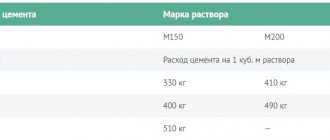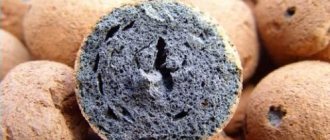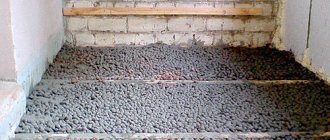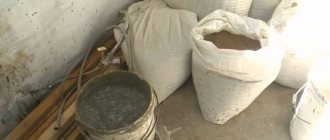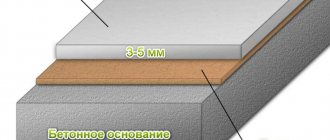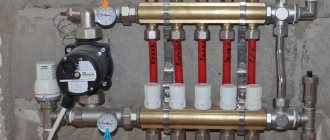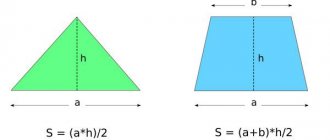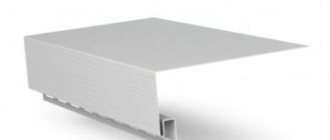Filling a floor screed in an apartment or industrial premises is a mandatory procedure. The finishing coating is laid on the leveled base or it is used without finishing as a working surface for industrial production. Before deciding how to calculate the amount of cement for floor screed, you need to find out the purpose of the room and the expected load on the concrete base.
One of the main criteria in preparing a solution for pouring a base is its thickness. It should be remembered that reinforcement with metal mesh is carried out with a minimum base thickness of 20 mm, a maximum pouring height of 40 mm, this is the thickness most often used for flooring in civil housing construction.
The next important point for calculations is the grade of cement. To organize the base, cement grades M300, M400, M500 are used. As a result of mixing with sand and water, a cement mortar with a value of M150 or M200 is obtained.
The brand of the mixture is determined based on the planned load on the base. Thus, M200 can be used to organize foundations in industrial buildings, for example, in garages, and the strength of the M150 grade is sufficient for pouring screed in an apartment.
To carry out calculations, it is necessary to know the rate of cement consumption to obtain a solution of a certain brand. So, to obtain one cubic meter of M150 grade mortar, you will need 330 kg of M500 cement or 400 kg of M400 cement. To obtain the same volume of brand M200 solution, you need to purchase 410 kg of M500 cement or 490 kg of M400 cement.
Let us calculate the organization of a base 40 mm thick for a room of 30 sq.m. in two versions: for mortar grade M150 and for grade M200 using cement grade M400. Calculation procedure:
- First you need to calculate the volume of fill in cubic meters. To do this, you need to multiply the area by the thickness (30x0.04). The resulting solution volume is 1.2 M3.
- Taking into account the rate of cement consumption per 1 m3 for M150 mortar and M400 cement, we obtain: 1.2 m3x400kg = 480 kg. The weight of one bag of cement is 50 kg, which means 10 bags will be required.
- Taking into account the rate of cement consumption per 1 m3 for M200 mortar and M400 cement, we obtain: 1.2 m3x490kg=588 kg, which corresponds to 12 bags.
- The amount of sand is calculated from a ratio of 1:3, which means for a solution of the M150 brand, you will need to purchase: 480x3 = 1,440 kg of sand, and for a solution of M200: 588x3 = 1,764 kg.
- The volume of water is added gradually until the required plasticity of the solution is obtained.
To carry out screeding work in an apartment, river sand is used; for industrial premises, sand from quarries is chosen.
This model for calculating cement consumption for floor screed is applicable for any area and thickness of the mixture layer. To obtain the area of the room, multiply the length and width of the room.
If the room configuration is complex, it is best to use the floor plan and calculate the area, referring to the paper. Thus, taking into account the ratio of 1:3, it will be possible to determine how much cement and sand is needed per cube of screed mortar.
Definition of mortar for screed
Before calculating how much cement and sand you need to screed the floor, you need to decide on the purpose of the leveling coating. This can be an independent or rough foundation, pouring engineering systems, or “warm floors.”
Among the determining criteria, the main ones are the grade strength and thickness of the monolith. The height in the residential sector is usually limited to 20 to 40 cm with reinforcing mesh.
To obtain screed grades M150 (in an apartment) or M200 (in a garage), Portland cement M400 and M500 is most often used. The table shows the content of binder clinker in one cubic meter of monolith.
| Concrete grade | Mass of cement M400 | Mass of cement M500 |
| M150 | 400 kg | 330 kg |
| M200 | 490 kg | 410 kg |
The higher the clinker indicator, the less it will need to be added to the solution. Strength is selected based on the expected load and traffic on the floor. For example, for a bedroom you can take M300 Portland cement, and for porcelain tiles in the hallway or on the stairs, in the garage you need to consider a higher strength identifier.
Portland cement M400 Source rabotniki.ua
Consumption is influenced, among other things, by the shelf life of the material. If Portland cement was made 5 or more months ago, then another 10-15% must be added to the calculated volume. This is justified by the fact that the quality characteristics of the binder clinker decrease over time.
See also: Catalog of companies that specialize in finishing materials and related work
For dry mixture
When using dry and semi-dry mixtures to organize screed, it is necessary to take into account the characteristics for each specific mixture, which can be found on the packaging. Usually indicate the volume of the mixture to cover one square meter of the base with a layer of 1 mm. For example, to obtain a solution of grade M100 sufficient for use indoors in residential premises, the manufacturer of semi-dry floor screed recommends the following consumption:
- mixture consumption is 2 kg per square meter with a screed thickness of 1 mm;
- water consumption is 0.22 l per 1 kg of mixture.
Taking into account the above data, you can calculate the required material for 30 square meters with a screed thickness of 40 mm.
It is necessary to multiply the area by the mixture consumption per 1 m2 and by 4 (since the planned thickness of the screed is 4 mm, and the calculation is given for a thickness of 1 mm). We get: 30x2x4 = 120 kg, while the volume of water required: 120 kg x 0.22 l = 26.4 liters.
(function(w, d, n, s, t) { w[n] = w[n] || []; w[n].push(function() { Ya.Context.AdvManager.render({ blockId: "RA-510923-1", renderTo: "yandex_rtb_R-A-510923-1", async: true }); }); t = d.getElementsByTagName("script")[0]; s = d.createElement(" script"); s.type = "text/javascript"; s.src = "//an.yandex.ru/system/context.js"; s.async = true; t.parentNode.insertBefore(s, t) ; })(this, this.document, "yandexContextAsyncCallbacks");
Calculation of the volume of the binder component
There are only two ways to calculate the amount of cement per screed: independently using tables or using online programs. For the first option, there is a formula based on the classic ratio of binder and sand 1 to 3, another 1 part goes to water. Here you need to multiply the thickness of the coating by the area of the room and divide the result by 5. For example:
- height – 35 mm;
- the length and width of the room are 6 and 5 m.
Then to level the floor you will need 0.035*30/5=0.21 cubic meters of cement. To convert the volume into kg, you need to know the density of the monolith or the weight of a cubic meter. Let's take 2 tons, typical for M150 screed with M400 clinker. That is, you will need 0.21*2000=400 kg or 16 bags of 25 kg each. For M200 concrete, 21 packages are respectively needed. Sand will need 1200 or 1544 kg.
Sand and cement are the basic components of the screed Source depositphotos.com
Cement consumption per 1 m2 of screed
Calculation of construction cement consumption for a 1m2 floor screed with a thickness of 5 cm:
- calculate the required cubic capacity of the mixture - 1m2 * 0.05 m = 0.05m2;
- cement consumption (m150) - 255 * 0.05 = 13 kg per 1m2.
When calculating all the costs for purchasing all the necessary materials, it is important to add the costs of their delivery. On the advice of experienced specialists, it is better to entrust such work to experienced craftsmen, because we are talking about the foundation on which housing or a work area will be equipped. Mistakes and savings, as a rule, in such cases lead to disastrous results and additional costs.
Video description
From the video you can learn how to calculate screed materials using a table on a computer without the Internet:
Overview of the consequences of incorrect calculations
If the content of one component changes, then this must necessarily affect the other two. Excess water makes the solution more convenient for distribution, but will significantly reduce the strength of the dry residue and increase the risk of cracks. Exaggeration of the clinker binder will have a positive effect on the hardness, but a negative effect on the internal stress of the monolith. This also leads to splits.
"People's" technology
Beginners often resort to mixing components “by eye,” usually using 1 or 3 parts of sand to one part of the cement mixture. The dry elements are initially mixed, and then water is added from the bucket.
But this option cannot guarantee that the required level of strength will be obtained and that the coating will not crack. If you add too much sand, the layer will dry out more slowly, which will make it easier to level, but the strength property will decrease. If more cement is added, the solution will set too quickly and the strength will be better. Therefore, the “folk” method can lead to the creation of a low-quality coating.
The dry elements are initially mixed, and then water is added from the bucket.
Compound
Concrete is widely used in construction. It is used for various purposes and according to this, the requirements for its preparation are established. However, in all cases it includes the following components:
- cement;
- sand;
- aggregate (small stones);
- water.
Additives can be used to give the material the necessary properties: moisture resistance, resistance to low temperatures, and others. Pebbles or small stones of various sizes can be used as filler. They increase the density of concrete, reduce drying shrinkage and make it more durable.
Various types of fillers Source spbbeton.org
Concrete grades have different properties suitable for solving specific problems. The consumption of materials depends not only on the type of concrete, but also on the type of cement used.
Next, the components that are necessary to create concrete will be discussed in more detail.
Crushed stone
It is necessary to give strength to concrete. As you know, concrete usually hardens completely in 28 days. From this time on, it acquires its maximum strength. During this process, the material shrinks. Properly selected aggregate can reduce shrinkage to a minimum.
By size, the stones used are divided into fractions according to their sizes:
- 2-20 mm;
- 20-40 mm;
- 40-70 mm.
This material is divided according to the type of stones used:
- from sedimentary rocks (limestone);
- obtained by crushing granite rocks;
- made by crushing pebbles.
Granite crushed stone Source piterpesok.ru
Granite crushed stone gives the solution maximum strength. It is used for concrete structures that are in difficult conditions. It is best suited for foundations, floors and other similar structures.
It is necessary to ensure that there is no clay or other impurities in the crushed stone.
Special Additives
They are used to improve the performance of concrete.
The following types of additives are used:
- Modifiers improve strength characteristics and resistance to frost.
- Designed to make concrete set faster. Although complete drying occurs in four weeks, it gradually gains strength during this period. When using setting accelerators, the material will gain maximum strength within the first 24 hours.
Antifreeze additive Source static.orgtorg.org
- Plasticizers help increase the mobility of the composition. This is especially important in cases where the concrete fills a complex shape. With high mobility, it will completely fill not only the entire volume, but also all the details of the structure. Plasticizers also improve the water resistance of this material.
- If concrete is used at low temperatures, its resistance to freezing is important. To increase cold resistance, special anti-frost additives are used.
- Mobility regulators promote slow cooling of the mixture. They can be useful during transportation to prolong their stay in a liquid state.
The amount of additives used should be determined based on the recommendations given by the additive manufacturer. Use in violation of the recommended proportions may reduce their effect or greatly change the result.
Additive for cement Source img.edilportale.com
See also: Catalog of stone house projects
Using sand
This material seems to be easily available, but you need to take into account that to create a concrete mixture you need sand of a certain quality. River or quarry sand is most suitable. In the first, the granules are larger in size. This sand is considered more preferable.
It is advisable to sift the sand before use so that there are no impurities left in it. The density is 1.3-1.6 tons per cubic meter.
Type of base to be poured
In the conditions of modern construction of private houses and multi-storey buildings for residential or commercial use, it is necessary to create high-quality interfloor ceilings and bases for laying floors. Before finishing with decorative materials, the substrate should be leveled. For this purpose, specialists can perform one of the following types of ties.
- Dry screed – produced using solid or sheet building materials. Used for leveling small areas.
- Cement-sand screed is a universal technology for leveling the base under tiles, linoleum, parquet, laminate, and wooden floors. Also, a screed with an iron-plated surface and decorative painting can act as a finishing option for flooring.
- Self-leveling screed - a ready-made mixture of industrial production allows you to quickly level any site. Particularly noteworthy is the ease of use and aesthetically attractive appearance of the finished coating.
Let's consider the most common type - cement screed. Let's understand the rules for calculating the volume of cement per cubic meter of classical pouring. Despite the wide range of ready-made mixtures for floor screed, the use of the solution will not become less relevant and in demand.
Calculation of the amount of material and proportions
So it is necessary to take into account the quality and strength of the material (both the mixture and the brick). Using basic standards, approximately 250 kg of M100 mixture should be used per 1 m3 of wall.
If you prepare the solution yourself, then the proportion should be 1 to 4. Liquid should be added to the CPS, which is usually half the total weight of the mixture.
Calculation for masonry
Regulatory documents contain detailed recommendations and the relationship between wall thickness and the amount of mortar used.
Examples are presented based on ordinary bricks and the required quantity per 1 m3:
- wall 12cm - 420 bricks and 0.19 m3 of mortar;
- wall 25cm – 400 bricks and 0.22 m3 of mortar;
- wall 38cm – 395 bricks and 0.234 m3 of mortar;
- wall 51cm – 394 bricks and 0.24 m3 of mortar;
- wall 64cm - 392 bricks and 0.245 m3 of mortar.
Introduction
In question No. 1 we will find out how many bags of the mixture are needed to obtain 1 cubic meter of the finished solution. We know that a solution is a combination of “water + mixture” in a certain proportion. We take a certain volume of the mixture, add a certain volume of water (according to the instructions) and get a certain volume of solution.
It is important to remember that the resulting volume of solution is often not at all equal to the volume of the final result, for example, from 1 m3 of sand concrete solution we will not get 1 m3 of finished screed (water evaporates, the mixture shrinks). We will find out, in fact, what shrinkage the finished solution gives when drying. We will consider how to do this in the answer to question No. 2.
Question No. 3 is closely related to questions No. 1 and No. 2, and in order to answer it, you need to solve the first two problems. You may also be interested in our article on gipsoplita.ru, where we described a method for calculating screed consumption on a slope.
Priority layer thickness
Even at the work planning stage, the dimensions of the screed are determined. According to GOST standards, the layer thickness should not be less than 4 cm. This is the lower limit, and it varies depending on the category of the object.
- The cement screed performed on top of the reinforced concrete slab has a height of 5 cm.
- In block construction, when the screed is poured over the waterproofing layer without the use of a reinforcing frame, the pouring thickness is from 7 cm.
- To create thermal insulation, when the building material is filled with sawdust or expanded clay, the layer thickness is from 10 cm.
If plasticizers are added to the solution, the layer thickness can be reduced by 10 centimeters.
Proportions of a classic DSP screed
The classic mortar for floor screed, as already mentioned, is cement with sand diluted with water. The proportion (the amount of sand per unit of cement) depends on the required strength of the screed and the brand of cement used. To make the floor surface durable, use expensive Portland cement grade M400 and higher.
Proportions of mortar for floor screed for M150, M200 and M300 when using different grades of cement
For screeding floors in utility rooms, you can also use the cheaper M300. It will cost a little more, but there will be savings. It is better not to use such cement for the foundation of a house or apartment under modern coatings. The rework will require significantly more savings on cement.
Beginners in the construction business think that if you take more cement, there will be a stronger screed. But no. For strength, the correct ratio of all components is important, and an excessive amount of cement can cause a decrease in strength. If you want a stronger screed, use high-quality cement and accurately measure the proportions. By the way, you shouldn’t take more water either. This will increase the fluidity of the solution, but will increase the number of shrinkage cracks. So once again: in order to get strong and reliable concrete, you need to strictly observe the proportions.
Which sand to take
It is better to take river sand, washed, of at least two fractions: coarse and medium. Why river? Because it has sharp edges, and this reduces the likelihood that it will settle into the lower layers. This is understandable. Why washed? It contains minimal dust. The less dust, the higher the strength of the solution. Sand is also needed in different sizes so that the strength of the solution is normal.
To screed the floor you need sand: washed river sand, two fractions (not fine)
If you are going to lay an expensive coating on the floor with high requirements for the strength of the base (parquet, parquet or engineered boards, vinyl tiles), it is better to take this kind of sand. There will be fewer problems.
Calculator for calculating the amount of concrete for pouring a floor in a garage
Probably all car owners dream of having a durable and reliable garage for their car. And if a lucky opportunity arises to build it, then many try, in order to save money, to carry out all or most of the work associated with it on their own. Whatever garage is built, it must have a durable, wear-resistant floor. In most cases, this can be solved by pouring a concrete base with or without further finishing at your discretion.
Calculator for calculating the amount of concrete for pouring a floor in a garage
The floor in the garage will definitely experience considerable mechanical loads, both static and dynamic, and in addition to this, it very often suffers the negative impact of temperature changes, high humidity, spilled fuels and lubricants or technical fluids. In short, the concrete for pouring the floor must be of high quality. The solution can be ordered from specialized companies or prepared at the place of work yourself. But in any case, you need to know how much concrete will be needed for pouring. And with self-mixing, you also get the required volume of initial components - cement, sand and gravel (fine crushed stone). A calculator for calculating the amount of concrete for pouring a floor in a garage will help in this matter.
Below the calculator itself, readers will find several necessary explanations for performing calculations.
Calculator for calculating the amount of concrete for pouring a floor in a garage
A few explanations on the calculations
- The calculation algorithm is simple - after specifying the dimensional parameters of the garage, the program will determine the total amount of concrete (in cubic meters) required to pour a screed of the required thickness (usually for garages, the thickness of the screed is taken to be at least 80÷100 mm, with mandatory reinforcement).
- The optimal grade of concrete for screeding in a garage is M300. To reach such an indicator, take the following proportional solution intake (by volume):
Additives: necessary or not?
It may be recommended to add plasticizers and fiberglass or other substances for micro-reinforcement to a classic floor screed solution. Are they needed or not? First you need to understand what it is and why.
When making a screed mortar, you can get by with only sand and cement
Plasticizing additives
Plasticizers are substances that increase the plasticity of DSP. It is easier to work with such solutions. Concrete with a plasticizer adheres better, is easier to level, and gives a smoother surface. In general, if all the components are of normal quality and well mixed, then it is not difficult to work with them when mixed with water. With additives, of course, it’s easier. But factory plasticizers cost a lot of money, and this increases the cost of the screed. They need to be added in small quantities, but when pouring the floor in a house, the cost is per cubic meter, so the costs will be noticeable.
When mixing, the proportions of the solution must be observed with great precision. To make the solution fit better, add plasticizers rather than more water
As usual, craftsmen have found a replacement for factory plasticizers. Add regular soap to the solution. Its consumption is very small - a glass or so for one concrete mixer. The plasticity of the solution increases, so many people use this type of additive. For beginners, it is worth saying: do not exceed the recommended dose. The solution will not get better, but it may well get worse. Soap increases plasticity by “lubricating” the sand, reducing its “adhesion” to the cement slurry. Exceeding the dosage may lead to a decrease in the strength of the screed. So be specific.
Micro-reinforcement
As you know, when drying, cement-sand mortar shrinks. The amount of shrinkage is from 1.5% to 3% of the volume. The exact percentage of shrinkage depends on the amount of foreign impurities (if the sand is washed, the shrinkage will be less), the correctly selected composition of the filler (in this case, sand), precisely observed proportions and a number of other conditions and factors.
This is what polypropylene fiber fiber looks like
Everything would be fine, but when shrinkage occurs, cracks form in the solution. They are always there, only larger or smaller in size, in larger or smaller quantities. To reduce the number of cracks, micro-reinforcement materials are added to the solution. Fiber fiber is most often used in everyday life. It happens:
- fiberglass;
- basalt;
- metal;
- polypropylene.
How to make a strong screed
In modern construction and repair work, the use of special additives has long been considered good form. The use of special additives makes it possible to make concrete of higher quality and reduce the labor intensity of work.
For screeds, it is recommended to use the universal superplasticizing and superwater-reducing additive CemPlast.
The addition of this superplasticizer (about 0.6 liters per 100 kg of cement) allows you to obtain highly mobile mixtures (increasing the mobility of the mixture from P1 to P5), which allows you to reduce the cost of concrete processing and pour a screed with a smooth surface.
Often, in order to increase the mobility of concrete mixtures, more water is added, which is a serious mistake, since excess water will not react with the cement components and will simply dry out, leaving voids in the concrete structure that reduce its strength. The addition of CemPlast allows you to obtain mobile mixtures by reducing the mixing water by 10–20%.
Nuances when calculating TsP
When making a floor screed for installing a heated floor, you need to take certain points into account. When calculating cement and other materials for preparing the mixture, it must be taken into account that the layer height above the pipes must be at least five centimeters. If the layer is more than 150 millimeters, then a lot of energy will be required to warm the floor and thus the efficiency of the heated floor is sharply reduced. Therefore, in order to reduce screed consumption and maintain the energy efficiency of the heated floor, granite chips are added to the mixture.
When carrying out floor repairs in an apartment, when opening and altering or laying a new screed, it is in fact considered a change in the configuration of the floor, and based on provision 2.2.6 of Resolution No. 508 - PP in Moscow, these works are considered reconstruction and therefore, to carry out this operation you need to obtain official permission and draw up and approve the project.
In addition, if a new screed is installed on top of the old one, the pressure on the floors increases significantly, which is extremely undesirable. Therefore, the consumption of cement per 1 m2 of screed must be done in such a way as not to increase the load on the floors.
Correct screed
